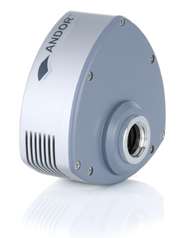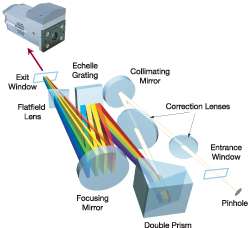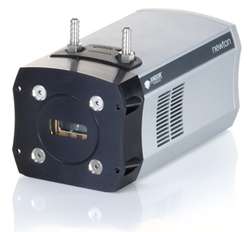Resources
 Part of the Oxford Instruments Group
Part of the Oxford Instruments Group
Expand
Collapse
 Part of the Oxford Instruments Group
Part of the Oxford Instruments Group
Light - A form of electromagnetic radiation. Visible light (400 nm to 770 nm) can be perceived by the unaided human eye.
Linearity - In CCD imaging technology, precise linearity dictates that an object that is twice as bright as another object will appear exactly twice as bright in the resultant image.
Liquid Nitrogen (LN) Cooling - Cooling of the CCD by direct contact of liquid nitrogen to the CCD cold block. The CCD is not run at LN temperature (-200°C) because the charge-transfer efficiency of CCD arrays actually begins to suffer at such a low temperature. Thus, operation is usually regulated between -120°C and -60°C in order to optimally decrease dark current without unduly compromising charge-transfer efficiency.

LucaEM - Luca is shorthand for Last Universal Common Ancestor and is Andor's latest mid-market EMCCD camera.For full specifications of the LucaEM, please refer to the Products section.
Mechelle - The Mechelle is Andor's spectrograph based on the èchelle grating principal and patented optical design, which gives extremely low cross-talk, equally spaced order separation and maximum resolution.
The Mechelle range of spectrographs offer a simultaneously recorded wavelength range from UV to NIR with very high resolution and no overlapping wavelengths.For full specifications of the Mechelle, please refer to the Products section.
Megapixel - A term used to describe a CCD whose imaging array contains at least one million pixels.
Microchannel Plate (MCP) - Microchannel plate. One of the major components of an image intensifier. A slightly conductive glass substrate with millions of parallel traversing channels containing a secondary electron emitter on their inner walls. Each channel acts analogously to a standard photomultiplier device.

Microlenses - Small lenses that increase the fill factor of interline-transfer CCDs by redirecting incident light away from the masked columns (storage arrays) to the pixels' photosensitive areas.
Multi-Pinned-Phase (Inverted) Operation (MPP) - A mode that reduces the rate of dark current generation by a factor of 20 or more, relaxing CCD cooling requirements to the level where a thermoelectric cooler is sufficient for most applications.
Near Infrared (NIR) - The region of the spectrum from about 0.77 µm to about 3.0 µm.
Newton - The world's FIRST spectroscopic camera with Electron Multiplying CCD technology. EMCCD is an innovative approach to amplifying very low light signals above the read noise floor of the CCD, which would otherwise set the detection limit of the system. It incorporates the all solid-state electron multiplying technology based on the Impact Ionisation phenomenon in silicon.For full specifications of the Newton, please refer to the Products section.

Noise - Noise is a complex topic, the full exploration of which is beyond the scope of this glossary.Noise may, however, be broken down into two broad categories:
PIXEL NOISE
FIXED PATTERN NOISE
Pixel Noise - Let us first attempt to define pixel noise.Assume that a light signal is falling on a pixel of the CCD. If the charge on the pixel is read and the read process is repeated many times, the noise may be taken as the variation in the values read.The Root Mean Square (r.m.s.) of these variations is often used to express a value for noise. As a rule of thumb, the r.m.s. is four to six times smaller than the peak to peak variations in the count values read from the pixel. Pixel noise has three main constituents:
Readout noise
Shot noise from the dark signal
Shot noise from the light signal itself
Shot noise cannot be removed because it is due to basic physical laws.Most simply defined, shot noise is the square root of the signal (or dark signal) measured in electrons. Readout noise (which in our detectors is, in any case, low) is due to the amplifier and electronics. It is independent of dark signal and signal levels; it is only very slightly dependent on temperature and it is present on every read, as a result of which it sets a limit on the best achievable noise performance. Shot noise from the dark signal is dependent on the exposure time and is very dependent on the temperature; shot noise from the signal is additionally dependent on the signal level itself.If either the signal or the dark signal falls to zero, their respective shot noise also falls to zero.The total pixel noise is not, however, simply the sum of the three main noise components (readout noise, shot noise from the dark signal, and shot noise from the signal). Rather, the Root Sum Square (r.s.s.) gives a reasonable approximation,thus:
Total = sqrt (readnoise2+ darkshot2 + sigshot2 )
where:
Total is the pixel noise
Readnoise is the readout noise
Darkshot is the shot noise of the dark signal
Sigshot is the shot noise of the signal
Fixed Pattern Noise - Fixed pattern noise (FPN) consists of the differences in count values read out from individual pixels, even if no light is falling on the detector.These differences remain constant from read to read. The differences are due in part to a variation in the dark signal produced by each pixel, and in part to small irregularities that arise during the fabrication of the CCD.Since fixed pattern noise is partly due to dark signal, it will change if the temperature changes, but because it is fixed, it can be completely removed from a measurement by background subtraction.
On-Chip Multiplication Gain - A technology that enables multiplication of charge (i.e electrons) collected in each pixel of the CCD’s active array. Secondary electrons are generated via an impact-ionization process that is initiated and sustained when higher-than-typical voltages are applied to an “extended” portion of the CCD’s serial register. Multiplying the signal above the read noise of the output amplifier enables ultra-low-light detection at high operation speeds. (Some CCD cameras with on-chip multiplication gain utilize two output amplifiers, an “on-chip multiplication gain” amplifier that allows the camera to be used for low-light, high-speed applications and a “traditional” amplifier for wide-dynamic-range applications.)
Opaque Mask - In CCD imaging technology, a light-impenetrable material that is used to shield selected parts of a photosensitive surface. Opaque masks are used in interline-transfer CCDs and frame-transfer CCDs.
Origin - In a CCD, the point located closest to the output node.
Output (Readout) Amplifier - A mechanism in the CCD that amplifies the electrons in the output node sufficiently to get the signal to the A/D converter. The output amplifier is the primary source of read noise.
Output Node - The location on a CCD (often a single pixel adjacent to the serial register) where charge is collected as a discrete picture element for CCD readout. Data enters the output node from the serial register and exits to the A/D converter.
Parallel (Vertical) Binning - The accumulation of multiple rows of charge in a CCD's serial register. The amount of charge shifted is defined by the user-specified binning factor.
Parallel Binning Factor - In the parallel register of a CCD, the number of pixels (in the parallel direction) to be shifted to the serial register, read out, and processed into an image. The binning factor is specified by the user in the imaging software prior to exposure of the CCD.
Parallel Direction - In a serial, parallel (s, p) coordinate system, the direction that begins at the origin and runs perpendicular to the serial register.
Parallel Offset - When defining an ROI in the parallel register of a CCD, the distance (in pixels) between the serial axis and the rectangular / square exposure area on the CCD.
Parallel (Vertical) Register - In a CCD, a large, square array that contains many potential wells (pixels). When the CCD is exposed to light, charge accumulates in the potential wells, which when shifted and read out, form an image.
Parallel Shift - In a CCD, columnar movement of charge from one or more pixels to an adjacent row. The movement continues until the number of pixels to be binned (specified by the user) are emptied into the serial register.
Parallel Size - In CCD imaging technology, the size of the ROI (in pixels) extending in the parallel direction.
Peltier Effect - The transfer of heat in the opposite direction of the current flow. By pumping current through a "Peltier stack" to a heat sink, heat can be removed from a CCD. The heat sink is cooled by circulating liquid or air. The temperature must be regulated.
Phosphor - A chemical substance that fluoresces when excited by X-rays, an electron beam, or ultraviolet radiation. Phosphors are composed of rare earth oxides or halides (e.g., gadolinium, lanthanum, yttrium) and usually emit green light with decay times ranging from hundreds of nanoseconds to a few milliseconds.
Phosphor Screen - One of the major components of an image intensifier. Electrons exiting the microchannel plate (MCP) are accelerated by a constant voltage and strike the screen, where they are converted back into light photons for detection by a CCD.
Photocathode - One of the major components of an image intensifier. Coatings on the photocathode convert a portion of the incident light photons into electrons. Good QE is critical, as photons that are not captured by the photocathode are lost from the final signal produced by the intensifier.
Photodiode Array (PDA) - A linear array of discrete photodiodes on an integrated-circuit chip used in digital detection systems.
Photometry - The measurement of the properties of light, particularly (luminous) intensity.
Photon-Noise-Limited Operation - In CCD imaging technology, operating the detection system at levels of noise so low that photon (shot) noise is the dominant noise source.
Pixel - Picture element. The smallest element in a visual display.
Poisson Distribution - A probability function used to model the density of counts of a randomly occurring event obtained during a specified interval of time.
Potential Well - In a CCD, a discrete region within the device's imaging array where an incident photon may be trapped (a pixel).
